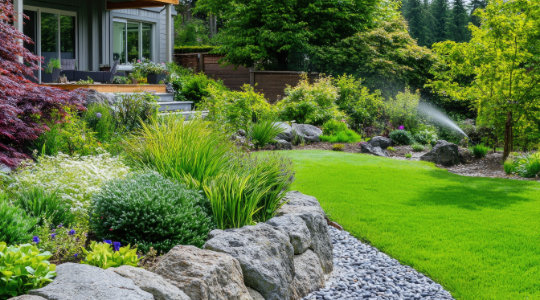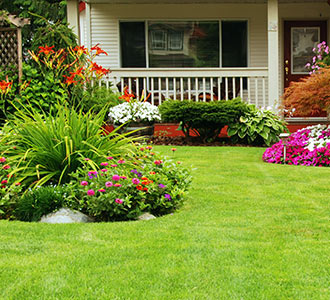Comprehending the Comprehensive Extent of Functions in Specialist Landscape Design Services
The comprehensive scope of professional landscaping services encompasses a range of basic aspects. It includes landscape style concepts, plant option, and hardscaping features. Additionally, it deals with irrigation systems and upkeep methods. Each aspect plays a crucial role in producing useful and cosmetically pleasing exterior spaces. Comprehending exactly how these parts interact can reveal much about the art and science of landscaping. Nevertheless, the trip right into this intricate field is simply starting.

Landscape Design Principles
Efficient landscape style concepts are vital for developing harmonious outdoor spaces that enhance both aesthetic charm and performance. These concepts assist the plan of elements within the landscape, making certain a natural aesthetic experience. Key parts consist of balance, which disperses visual weight evenly; proportion, which associates the size of various elements per various other and the room; and unity, which creates a sense of integrity via consistent themes and materials.
Additionally, focus directs attention to focal points, while rhythm establishes activity through repetition of design functions. The efficient use line can develop paths and lead the eye through the landscape. Furthermore, understanding the site's topography, climate, and existing features is vital for assimilation with the surrounding environment. By sticking to these foundational principles, landscape developers can craft rooms that not just look appealing but likewise serve their intended purpose, enhancing the overall experience for users.
Plant Option and Installment
In the domain name of expert landscape design, plant selection and installment play a vital role in accomplishing a prospering garden - landscaping services. Emphasizing indigenous plant advantages, seasonal factors to consider, and the specific dirt and sunlight requirements of each varieties assures a sustainable and aesthetically pleasing landscape. Careful preparation in these areas not just boosts biodiversity but also promotes lasting eco-friendly health and wellness
Indigenous Plant Advantages
Why should property owners take into consideration native plants for their landscaping jobs? Indigenous plants supply many benefits that boost both aesthetic appeals and environmental sustainability. They are well-adapted to regional environments, needing less water and upkeep compared to non-native types. This durability decreases the demand for chemical fertilizers and chemicals, promoting a much healthier ecosystem. Furthermore, indigenous plants supply environment and food for local wildlife, consisting of pollinators, which can increase biodiversity in houses. Their familiarity with neighborhood soil and climate conditions likewise brings about much better development rates and long life. By selecting indigenous plants, home owners not only develop aesthetically enticing landscapes however also add to eco-friendly conservation, making a positive influence on their local environment. Native plants represent a smart selection for landscape design jobs.
Seasonal Plant Considerations
Home owners that have welcomed native plants in their landscape design can better enhance their outdoor rooms by taking into consideration seasonal plant options. By incorporating plants that flourish in particular seasons, they can develop vibrant and aesthetically enticing landscapes throughout the year. Springtime may usher in lively blooms like daffodils and tulips, while summertime can display lavish vegetation and vibrant perennials. Fall presents a scheme of cozy tones with asters and goldenrods, while winter season can be highlighted with evergreens and decorative lawns for appearance. Specialist landscaping companies typically suggest choosing plants that not only complement existing native species however likewise supply year-round rate of interest and assistance regional wildlife. This thoughtful method to seasonal plant choice guarantees a continuously developing and sustainable garden atmosphere.
Soil and Sunlight Demands
Effective landscape design hinges on recognizing the particular dirt and sunlight demands of plants. Different species prosper under varying conditions, needing a cautious evaluation of both variables during the selection procedure (landscaping services). Dirt types, such as sandy, clay, or loamy, influence drainage, vitamins and mineral accessibility, and origin development. In addition, pH degrees can influence plant health and wellness, necessitating soil testing to ascertain suitability. Sunlight requirements vary significantly; some plants grow in full sun, while others favor complete or partial shade. An expert landscaper thinks about these aspects to assure peak development and aesthetic appeal. By straightening plant choices with the environment's particular features, landscapes can achieve sustainability, resilience, and visual consistency, eventually leading to effective plant facility and long-term maintenance
Hardscaping Features and Construction
While landscape design often stimulates pictures of lush plant and vivid flowers, hardscaping functions play a vital function in defining outdoor spaces. These components, which include outdoor patios, walkways, retaining wall surfaces, and attractive stonework, give structure and performance to gardens and yards. Hardscaping makes use of products such as concrete, block, wood, and stone, enabling varied styles that match the natural landscape.
The building of hardscaping features requires mindful planning and execution to ensure durability and aesthetic appeal. Professionals analyze website conditions, drainage, and spatial connections to produce natural outside atmospheres. Correct setup strategies are vital, as they stop problems like erosion and changing over time.
Integrating hardscaping not only boosts the aesthetic passion of a property but additionally helps with exterior activities, making it a basic element of comprehensive landscape design services. Eventually, thoughtful hardscaping adds to both the capability and appeal of exterior rooms.
Watering Equipments and Water Monitoring
Reliable watering systems and water monitoring are important elements of expert landscape design, as they assure that plants obtain the required hydration for excellent growth. These systems can differ from easy drip irrigation arrangements to innovative computerized lawn sprinkler systems, created to fulfill the certain demands of varied landscapes. Correct water management not only enhances water use, minimizing waste, however also improves plant health and wellness and decreases illness dangers.
Landscape design professionals assess numerous aspects, including soil type, plant varieties, and regional environment, to develop customized irrigation remedies. Additionally, incorporating rain harvesting strategies can better boost sustainability and performance (Read More). Regular upkeep of irrigation systems is important to keep performance and prevent leakages, which can lead to water loss and increased expenses. Eventually, a properly designed irrigation system plays a critical function in protecting the aesthetic charm of outside spaces while promoting eco-friendly stewardship within specialist landscaping practices
Lawn Care and Maintenance Strategies
Yard treatment and upkeep methods are fundamental for attaining a rich, healthy yard that enhances the total landscape. These approaches include various techniques focused on promoting optimal development and visual allure. Normal mowing is important, as it urges thick, even development while avoiding weeds from establishing. In addition, proper fertilizing supplies necessary nutrients, with applications tailored to the certain yard type and soil conditions.
Watering methods ought to concentrate on deep, infrequent watering to encourage origin advancement, while aeration enhances soil framework and promotes nutrient absorption. Parasite and disease monitoring is also essential; recognizing problems early permits effective treatments that decrease damages.
Ultimately, overseeding can revitalize thin or damaged yards, enhancing thickness and color (landscaping services). By applying these targeted yard treatment strategies, landscaping professionals can guarantee that lawns continue to be dynamic and healthy throughout the periods, greatly adding to the general appeal of the building
Seasonal Landscape Treatment and Upkeep
As the seasons modification, correct landscape treatment becomes vital for maintaining the health and wellness and elegance of outside areas. Each period provides one-of-a-kind challenges and requirements. In spring, landscape professionals concentrate on pruning, growing, and fertilizing to motivate growth. Summer demands normal watering, weed control, and insect administration to safeguard newly established plants.
Autumn requires the preparation of yards for winter months, including mulching, fallen leave removal, and the planting of light bulbs for the following springtime. Furthermore, winter months care includes protecting prone plants from frost and guaranteeing that Full Article hardscapes are practical and risk-free.
Throughout the year, seasonal landscape upkeep guarantees that outside areas remain visually appealing and healthy and balanced. Specialist services can provide customized upkeep plans that adjust to the certain requirements of each season, permitting residential or commercial property proprietors to enjoy vivid landscapes year-round. Generally, seasonal treatment is a crucial element of professional landscaping that promotes longevity and aesthetic value.
Sustainable Landscaping Practices
An expanding variety of homeowner are embracing lasting landscape design techniques to produce eco-friendly outdoor areas. These practices concentrate on preserving resources, improving biodiversity, and minimizing ecological effect. Native plants are commonly picked for their low water requirements and compatibility with regional ecological communities, lowering the demand for chemical fertilizers and chemicals. Rainfall gardens and absorptive paving are used to manage stormwater runoff, advertising groundwater recharge and decreasing disintegration.
In addition, sustainable landscaping includes natural horticulture techniques that focus on dirt wellness and promote all-natural insect control. Effective irrigation systems, such as drip irrigation and rainwater harvesting, aid enhance water usage. In addition, landscape developers progressively support for the usage of recycled products, such as recovered wood and stones, to lessen waste. By taking on these sustainable methods, residential property owners not just add to eco-friendly conservation but likewise produce cosmetically pleasing atmospheres that can flourish with minimal upkeep.
Frequently Asked Inquiries
For how long Does a Landscaping Task Commonly Take to Total?
Generally, a landscaping job can take anywhere from a few days to a number of weeks to finish, relying on the task's design, complexity, and dimension demands. Read More. Factors such as climate and source accessibility also affect timelines
What Variables Impact the Expense of Landscape Design Services?
Various factors affect landscape design solution expenses, including project size, design complexity, worldly top quality, labor expenditures, geographic location, and seasonal need. Each element adds distinctly to the general economic requirements of a landscaping project.
Are Landscaping Services Available Year-Round?
Landscaping services are normally available year-round, although schedule might differ based upon region, seasonal weather, and particular solution offerings. Some services may be limited throughout extreme weather condition or off-peak seasons.
Do Landscaping Firms Deal Guarantees on Their Job?

Can I Layout My Landscape Without Expert Help?
Yes, individuals can design their landscapes without professional aid. Nonetheless, they may lack experience in plant choice, layout, and environmental considerations, potentially leading to less reliable designs that could call for pricey adjustments later.
